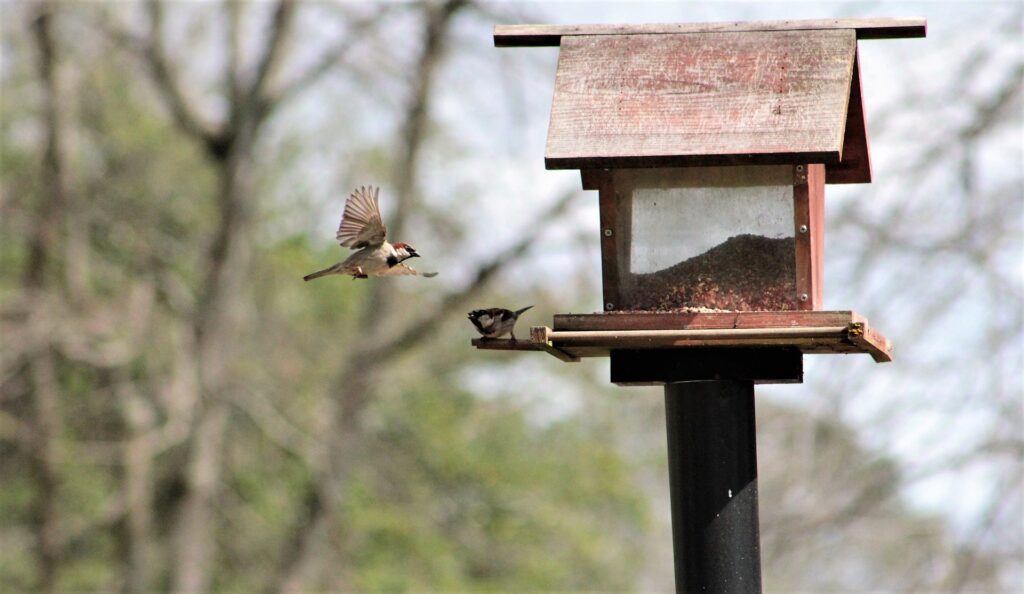California is home to more than 600 species of birds, making it one of the best places in the nation to enjoy birdwatching. And Big Bear alone is home to 250 different species of birds—including those that are rare and endangered. If you live in the Big Bear area, how do you attract more types of birds to your backyard for some up-close-and-personal birding entertainment? Here are some expert tips that won’t disappoint.
Put Out More Feeders

Seems like a no-brainer, right? The more birds you want to attract, the more bird feeders you should add to your yard. It’s also important to use different types of feeders, filling them with different bird favorites. For example, try a suet feeder here, a tube feeder filled with a seed mix there, and a tray feeder with mealworms in another area. But first, find out which foods your local birds crave.
Hang Feeders at Different Heights

Because different birds feed at different heights, it’s wise to hang feeders where your favorite birds are likely to eat. For instance, hummingbird feeders should be hung 4-6 feet from the ground, while oriole feeders should be hung at 6-10 feet. And woodpeckers are tree feeders, so you’ll have more chance of attracting them if you hang your feeder at least 10 feet off the ground.
Place Feeders Near Shelter

As natural prey, birds are always looking for safe spaces from predators. This is especially true when they’re feeding. Hanging or mounting your feeders about 10-12 feet from trees, dense shrubs, or brush will bring in more birds, who will appreciate a place to rest, away from bad weather and predators.
Offer New Types of Bird Food

You can still attract a variety of birds with a basic seed mix that doesn’t break the bank, like Chirp’s Value Mix. But if you’re looking to attract a certain type of bird, you’ll need to get more specific with the food you’re putting out. Black-oil sunflower seeds are a crowd pleaser with many bird species, so you can’t go wrong with a high-quality mix like our Big Bear Blend. Here are some other bird foods to try, and the birds that love them*:
- Suet: Chickadees, towhees, jays, orioles, titmice, nuthatches, bluebirds, tanagers, juncos, mockingbirds, nutcrackers, and woodpeckers. For more help, see our Southern California Suet Guide and browse Chirp’s suet selection.
- Nuts and seeds: Creepers, chickadees, wrens, titmice, doves, woodpeckers, American robins, jays, blue tits, and towhees.
- Nectar: Hummingbirds, thrashers, orioles, and finches. Browse Chirp’s selection of clear nectar mixes—available in both liquid and powder.
- Fruit: Orioles, chickadees, grosbeaks, American robins, jays, waxwings, cardinals, finches, kinglets, tanagers, and titmice.
- Insects: Bluebirds, chickadees, nuthatches, orioles, starlings, purple martins, flycatchers, towhees, and warblers. Learn more about how to attract bug-eating birds to your yard and shop Chirp’s insect foods.
*These are not exhaustive lists.
Add a Birdbath with Moving Water

Birds are looking for food, water, and shelter—and by providing all three, you maximize your chances of attracting a larger variety of birds. Birdbaths are not only attractive water features, they’re also a welcome respite where birds can drink and bathe on hot summer days. However, since birds need to bathe and drink in every season, a birdbath is functional all year long. And because birds are attracted to movement, birdbaths with moving water—like bubblers and fountains—catch their attention faster than still water.
Having trouble attracting birds to your birdbath? It could be one of these six reasons.
Install a Bird House or Nesting Box

Just like when we shop for a new home, we’re looking for a place that ticks all the boxes. For nesting birds, these boxes are food, water, shelter, a safe place to raise their young. When you mount a bird house, nesting box, or roost box on your property, you’re giving birds a place to consider when they’re scouting out new nesting spots. And if you offer food, water, and natural places to shelter (like trees, bushes, and brush piles), you’re cornering the bird house market!
Special Summer PSA: What to Do When You Find a Baby Bird on the Ground

With summer in full swing, it’s the time of year when fledgling birds are trying out their new wings for the first time. You may find them on the ground, flapping away, and think they’re in trouble—but are they? And how can you tell the difference between a fledgling, a hatchling, and a nestling? (Hint: the latter two are younger birds.) And should you intervene and help the bird or leave it alone? The answers to all of these questions can be found in our post “What To Do When You Find a Baby Bird on the Ground.” We’ve also made this handy infographic, as an easy visual guide:

Stay Connected with Chirp!

We’d love to connect with you! Follow us on Facebook and Instagram to find out about our upcoming bird walks and talks. (You can also visit our Activities page for information on these live and virtual events.). And visit our YouTube page for virtual bird walks and talks, how-to videos on backyard bird feeding, and other nature-themed fun for the entire family!



One comment
Awesome and soooo important info to and for our great Big Bear Birds! Thank you sooo much!!!